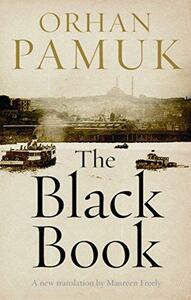Take a photo of a barcode or cover
I just didn't care enough to finish this book. A little to angst ridden for me.
challenging
mysterious
reflective
slow-paced
Plot or Character Driven:
Character
Strong character development:
Complicated
Loveable characters:
Complicated
Diverse cast of characters:
No
Flaws of characters a main focus:
Complicated
God I am finally done with this book, I thought it was never going to end. Though there are chapters that completely me drew me in, I think that ultimately I do not know enough about Turkey to be able to appreciate the more opaque sections, which made them drag on and on. The narration alternates between the story and some articles published by one of the characters. It is less about plot and more about ideas concerning identity: what is identity, how people influence our identities, how our wanting to be other people changes us, how Istanbul deals with being stuck between east and west, how modernization changes identities, how you can pass off as another person without effecting any change etc. etc. Interesting stuff to think about for a while.
What I liked:
1) The ambiance is like a film noir. Galip is looking for his missing wife, Ruya and his cousin Jelal. In this search we get taken to a lot of hidden-in-plain-sight places in an always-snowing Istanbul: a multi-generational apartment building that has seen better days, a store that sells everything, a mannequin maker, a cafe meeting between three scholars, a palace with a prince who tries to see his own city. It's all super atmospheric and lived-in, and always a little bit unnerving, somehow.
2) Some of the articles interspersed with the narration are very interesting. There is about 15 of them, but the ones I liked most are: The one about the potential day that the Bosphorus dries up, the one about three writers offering tips to a newbie and throwing backhanded shade at one another, the one about a mannequin maker who creates figurines that nobody likes because they look too lifelike and people want western-looking mannequins, the one about Aladdin's shop and how he deals with customers asking him for the absurdist items and the bad attitude they give him, and the one about a mirror that reflects reality just a little bit differently.
What I liked:
1) The ambiance is like a film noir. Galip is looking for his missing wife, Ruya and his cousin Jelal. In this search we get taken to a lot of hidden-in-plain-sight places in an always-snowing Istanbul: a multi-generational apartment building that has seen better days, a store that sells everything, a mannequin maker, a cafe meeting between three scholars, a palace with a prince who tries to see his own city. It's all super atmospheric and lived-in, and always a little bit unnerving, somehow.
2) Some of the articles interspersed with the narration are very interesting. There is about 15 of them, but the ones I liked most are: The one about the potential day that the Bosphorus dries up, the one about three writers offering tips to a newbie and throwing backhanded shade at one another, the one about a mannequin maker who creates figurines that nobody likes because they look too lifelike and people want western-looking mannequins, the one about Aladdin's shop and how he deals with customers asking him for the absurdist items and the bad attitude they give him, and the one about a mirror that reflects reality just a little bit differently.
challenging
mysterious
slow-paced
I found this a difficult read, but a very rewarding one. It's not that the language is difficult, nor the vocabulary, nor the unfamiliar setting in Istanbul in 1980. What's difficult is the layers of feeling, thought, and culture through which this novel carries us, like a strong current in a sea. The structure takes a bit of getting used to: alternating chapters place us with Galip, our 40-something narrator, or in one of many newspaper columns written over many years by his uncle Celal. The two types of chapters of course refer backward and forward to one another.
To some extent the reader is not expected to understand what is going on because in one way (but only one of many), the story is a mystery. Galip's wife, Ruya, and his uncle Celal have disappeared, and Galip is searching for both of them. But all the reviews of this book that emphasize this mystery, or make parallels to the detective novels that Ruya loves to read, are looking at only one slender aspect of this multi-layered novel. It is like the sea, with layers and layers of different temperatures and density and life-forms.
Some passages absolutely carried me away -- rare for a translation. The translator's note at the end was fascinating, portraying Turkish as a most unusual language, and very challenging to render into English.
In some ways it's like the reader is going down a rabbit hole with Galip, into a kind of madness or frenzy, when he sees letters etched upon all the faces of everyone on the streets. He wants to be someone else, he becomes someone else, he wanders the twisting streets of old Istanbul in fabulous disguises (or does he only dream of doing that?), which apparently some sultan famously used to do long ago. He has loved Ruya since they were children, but it's unclear whether she has ever loved him, or even why they married at all. The columnist Celal has influenced and inspired not only Galip but apparently all of Istanbul -- his daily columns are must-reads for everyone, and they debate and complain and exalt in his stories. It's a love-hate thing -- his columns are as likely to make people angry as to inspire them.
I think reading this a second time will help me understand it better.
NOTE: The edition I read, which is copyright 2006 by translator Maureen Freely, is her SECOND version of this book. Her "Translator's Afterword" explains this. She worked closely with author Orhan Pamuk on her translation, and it was the third novel by Pamuk she had translated. In spite of all that, she judged the first attempt to be "somewhat opaque," and so she gave it another try. This seems most unusual to me, but I can vouch for the clarity of the writing and the lyrical, seductive quality it emits.
To some extent the reader is not expected to understand what is going on because in one way (but only one of many), the story is a mystery. Galip's wife, Ruya, and his uncle Celal have disappeared, and Galip is searching for both of them. But all the reviews of this book that emphasize this mystery, or make parallels to the detective novels that Ruya loves to read, are looking at only one slender aspect of this multi-layered novel. It is like the sea, with layers and layers of different temperatures and density and life-forms.
Some passages absolutely carried me away -- rare for a translation. The translator's note at the end was fascinating, portraying Turkish as a most unusual language, and very challenging to render into English.
In some ways it's like the reader is going down a rabbit hole with Galip, into a kind of madness or frenzy, when he sees letters etched upon all the faces of everyone on the streets. He wants to be someone else, he becomes someone else, he wanders the twisting streets of old Istanbul in fabulous disguises (or does he only dream of doing that?), which apparently some sultan famously used to do long ago. He has loved Ruya since they were children, but it's unclear whether she has ever loved him, or even why they married at all. The columnist Celal has influenced and inspired not only Galip but apparently all of Istanbul -- his daily columns are must-reads for everyone, and they debate and complain and exalt in his stories. It's a love-hate thing -- his columns are as likely to make people angry as to inspire them.
I think reading this a second time will help me understand it better.
NOTE: The edition I read, which is copyright 2006 by translator Maureen Freely, is her SECOND version of this book. Her "Translator's Afterword" explains this. She worked closely with author Orhan Pamuk on her translation, and it was the third novel by Pamuk she had translated. In spite of all that, she judged the first attempt to be "somewhat opaque," and so she gave it another try. This seems most unusual to me, but I can vouch for the clarity of the writing and the lyrical, seductive quality it emits.
This novel has some absolutely beautiful passages, but the narrative kind of spins in circles and then fizzles out in the last half.
I must read this book again.
Pamuk has told me a story that can only be told with more stories. Mere words are not enough, but they are all he has, so he has molded and forged and reformed their meanings through stories and stories of stories to help me hear his story.
I must read this book again.
Pamuk has told me a story that can only be told with more stories. Mere words are not enough, but they are all he has, so he has molded and forged and reformed their meanings through stories and stories of stories to help me hear his story.
I must read this book again.
Monumental. If you read this book based on my review and do not agree, please contact me.
Mine was the Limited Release from S. Fischer Verlag GmbH in November 2009. Harcover, without the circle on the cover, included a silver woven bookmark attached to the spine. Same ISBN.



